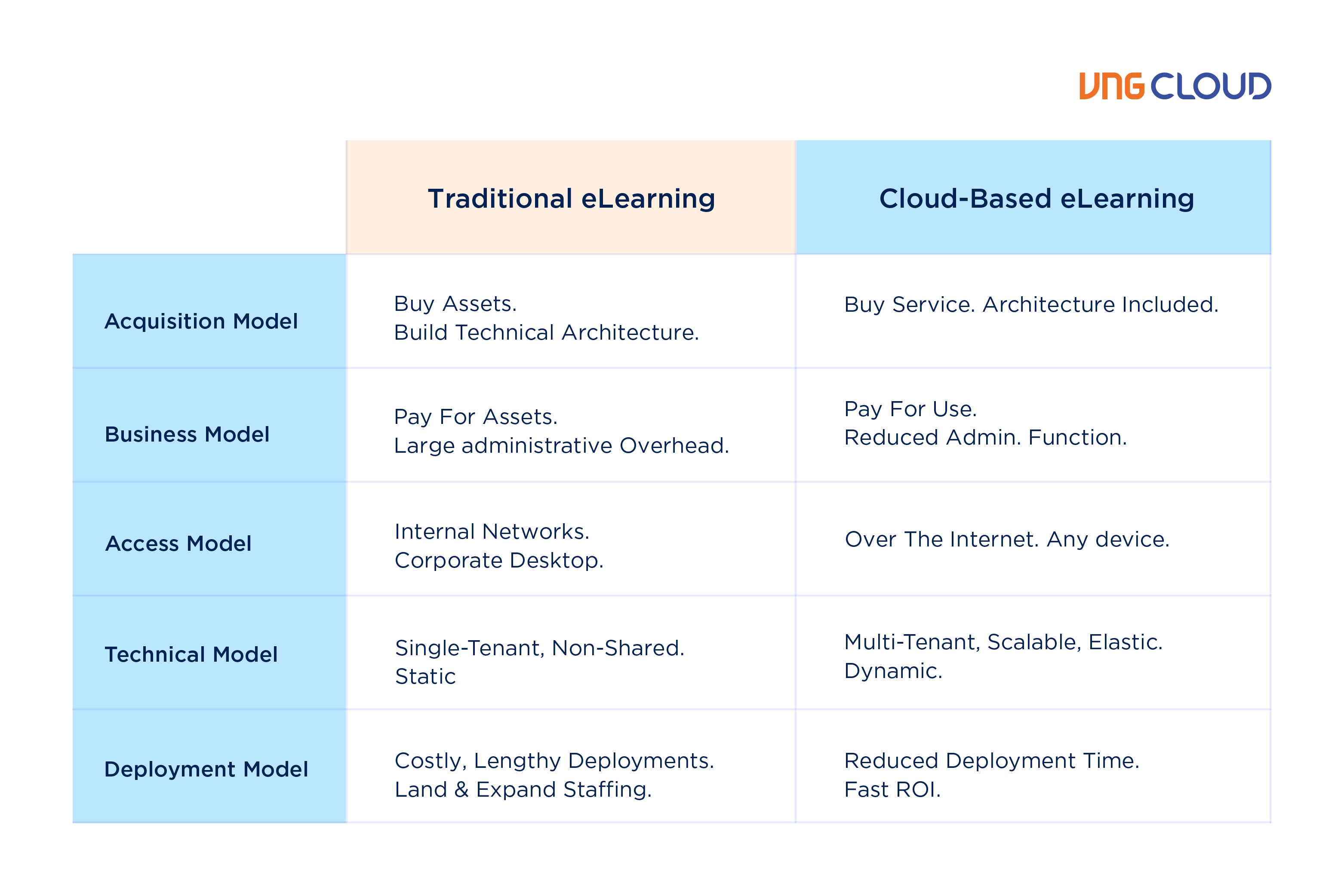Following the frequent lockdowns enforced by governments due to the pandemic, eLearning applications and EdTech companies have become prominent sections of the education industry. These software solutions and their providers are gaining traction within the education sector, including schools, colleges, and universities. The cloud computing platform has played a significant role in facilitating eLearning in recent times. Its scalability, accessibility, data processing capabilities, and security features have made cloud-based eLearning a leading player in the market. As a result, education service providers and IT solution providers for universities have widely embraced this technology.
The conventional eLearning resources are stored on distinct servers, including educational material, as well as supplementary infrastructure like Learning Management Systems, authoring tools, and supporting software, etc. In contrast, the cloud-based eLearning approach utilizes a consolidated infrastructure that includes content, authoring tools, Learning Management Systems, databases, and more.
Below is a comparison between traditional eLearning and cloud-based eLearning:

Benefits of Cloud-based eLearning
What are the benefits of using cloud-based eLearning? There are numerous advantages to incorporating cloud computing technology into eLearning, such as:
1. Low Cost
Users of eLearning on computers do not need to configure the eLearning applications. They can access cloud-based applications on their PC, mobile phone, or tablet with an Internet connection, with minimal setup required. As data is created and stored in the cloud, users do not have to invest in large amounts of memory to store data on their local devices. Additionally, organizations only pay for the space they require, based on usage, which is a more cost-effective approach.
2. Improved Performance
As most of the applications and processes in cloud-based eLearning are handled in the cloud, client machines do not experience performance issues during operation.
3. Instant Software Updates
Cloud-based eLearning applications run with high-performance capabilities and are automatically updated with the latest software. As a result, online learners can receive new documents quickly and easily.
4. Improved Compatibility with Document Formats
Cloud-based eLearning applications do not encounter issues with file formats or fonts failing to open on certain PCs or mobile devices. This is because these applications retrieve files from the cloud, thereby eliminating compatibility concerns.
5. Benefits For Learners
Cloud-based eLearning offers learners numerous benefits. They can enroll in online courses, take exams remotely, receive feedback from instructors, and submit projects and assignments online.

6. Benefits For Instructors
Cloud-based eLearning provides several benefits to instructors as well. They can create online tests for students, utilize content management systems to interact more effectively with students and offer improved resources and assessment tests. Instructors can also provide feedback and communicate with learners through online forums.
7. Information Security
Data security is a significant concern when it comes to cloud-based eLearning, as both the software and data are stored on remote servers that could potentially crash or disappear without notice. Despite this, cloud computing offers substantial security benefits to individuals and companies using or developing eLearning solutions.
Overall, cloud-based eLearning is poised to become a game-changer in the realm of learning technology, given its numerous advantages. With ongoing advancements in cloud computing and ever-increasing Internet speeds, its potential will only continue to grow.
Building the Future of Education with Cloud Technology
The education industry particularly benefits from a handful of notable and advantageous features offered by cloud services. Let’s find out how cloud technology is building the future of education:
1. Remove Dependence on Physical Infrastructure
Cloud computing platforms provide the education sector with a significant advantage by enabling students to be free from the constraints of physical infrastructure. High-quality digital classes and learning sessions can effectively replace textbooks, physical libraries, and in-person instruction. Moreover, digital learning offers omnipresent accessibility, allowing students to access learning portals, virtual libraries, and attend online classes from any location, device, and at any time. As a result, cloud-based platforms have become a leading technology in the market for eLearning and digital education.
2. Maximize ROI with Cloud-Based EdTech Solutions
By integrating with student and customer data, a company specializing in cloud-based education technology (EdTech) can analyze preferences and develop customized eLearning solutions and study materials. This can result in a higher ROI and greater profit margins for EdTech companies. The use of cloud computing resources ensures high and scalable server performance. As a result, the workload for tutors is reduced and a self-learning process is established, resulting in a more reliable, robust, and resilient education system.
3. Enhance Data Security and User Experience in eLearning
In the eLearning industry, security is crucial for success. A high-tech and user-friendly interface that enables advanced data sharing is essential to eliminate concerns regarding data security. It ensures the secure flow of data and prevents information loss, providing a seamless user experience at every touchpoint of the business environment. In cases where data flow is high in terms of bulk and volume, a cloud-based strategy can effectively manage external attacks and ransomware by providing constant monitoring, supervision, and analysis.
4. Pay-as-you-go model
Paying based on the number of services utilized brings flexibility for business expenses, which is particularly advantageous for schools, colleges, and universities with varying demands and requirements. With everything facilitated in the cloud, there is almost no need for educational institutions to purchase and maintain their own IT framework. This is especially valuable during times of change or uncertainty as it provides flexibility and time for planning, while ensuring that the organization pays only for the services it uses. By using Pay-as-you-go model, educational institutions can rely on automated cloud services to track their objectives quickly and reliably, while also monitoring progress in research and development.

5. Regular Updates on Vital Information
The effectiveness of eLearning is dependent on the availability and flow of the latest updates, data, and information. Access to this information enhances the functionality of the eLearning process and improves the decision-making abilities of eLearning companies. In addition, tutors and facilitators can use a functional, collaborative, and integrated ecosystem deployed within the cloud to provide on-the-job training.
6. A Prototype for New Business Ideas
Cloud technology has revolutionized collaboration between students and teachers, enabling them to engage in video conferencing, document sharing, and tutorial sessions. This transformation has facilitated innovation-driven growth for the education industry. Automated processing of information, the ability to obtain new actionable business insights, and scaling up opportunities for tremendous productivity and circular growth have propelled cloud-based educational services. This technology is a boon for educational organizations seeking growth.
Final thoughts
According to a 2021 Gartner CIO survey on higher education perspectives, digital involvement in higher education, schools, and universities has accelerated the adoption of new technologies, products, solutions, and services in this market. The introduction of cloud-oriented learning is just the beginning of this revolution, and we can expect to witness the innovation of new technologies such as advanced analytics, IoT, and automated scaling of applications. These facts demonstrate that cloud computing technologies facilitate growing prosperity and a higher ROI for businesses. Therefore, it has become imperative and vital for EdTech companies and educational organizations to leverage cloud computing technology.
Technology is an integral part of businesses worldwide, including the education sector. Gone are the days when education was limited to manual paperwork within a physical classroom. Today, educational institutes and universities can make digital learning more accessible by incorporating more cloud-based computing services.
Cloud adoption in education has the potential to revolutionize the way we learn and teach. With its flexibility, accessibility, and scalability, cloud technology enables students and educators to collaborate seamlessly across locations and devices, access vast amounts of information, and personalize their learning experiences. The benefits of cloud adoption in education are manifold, including cost savings, increased efficiency, and improved student outcomes. As we look to the future, it is clear that cloud technology will continue to play an increasingly vital role in shaping the education landscape. By embracing cloud technology, we can equip the future generation with the tools they need to succeed in an ever-evolving digital world.